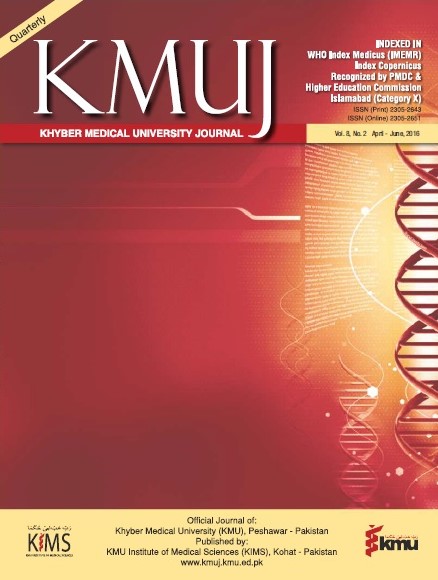RISK FACTOR OF SEXUALLY TRANSMITTED INFECTIONS AMONG PAKISTANI MALES
Main Article Content
Abstract
OBJECTIVE: To examine the socio-demographic factors, associated with sexually transmitted infections (STIs) among Pakistani males.
METHODS: Bivariate and binary logistic regression analysis carried out
by using the Pakistan Demographic and Health Survey (PDHS) data
set 2012-13, conducted by National Institute of Population Studies,
Pakistan.
RESULTS: Every 7 out of 10 ever-married men have heard about STIs
and every 5 out of 10 believed that the risk of getting HIV/ADS can be
reduced by always using condoms during sex. Bivariate analysis revealed that age, place of residence, education status, media access and wealth index were found to be significant i.e. (p<0.0001) with respect to STIs knowledge. Binary logistic regression model confirmed that younger participants had lack of knowledge [OR=0.127] compared to upper age-groups. Urban residents were more aware of STIs [OR=1.740]compared to rural residents. Illiterate participants had less knowledge regarding STIs [OR=.037] compared to people with higher education status. Media exposure was also positively associated with knowledge of STIs. The participants reading newspaper, listening to radio and watching television had more knowledge regarding STIs [OR= 2.082, 1.240 and 1.936] compared to people with no access to any sort of media.
CONCLUSION: Participants with no education, low socio economic
status, profound lack of media exposure, those living in rural areas and early ages are on greater risk to be affected with STIs. These statistical outcomes about STIs knowledge and exploration of significant socio demographic factors of ever-married men can be an emerging for disease management and prevention.
KEY WORDS: Sexually Transmitted Diseases (MeSH), Sexually Transmitted Infections (MeSH), Pakistan (MeSH); Socio demographic determinants (Non-MeSH)
Article Details
Work published in KMUJ is licensed under a
Creative Commons Attribution 4.0 License
Authors are permitted and encouraged to post their work online (e.g., in institutional repositories or on their website) prior to and during the submission process, as it can lead to productive exchanges, as well as earlier and greater citation of published work.
(e.g., in institutional repositories or on their website) prior to and during the submission process, as it can lead to productive exchanges, as well as earlier and greater citation of published work.
References
National AIDS control program (2012) Country progress report Pakistan, 1-91.
Mir, A. M., Wajid, A., Reichenbach, L., & Khan, M. (2009). STI prevalence and associated factors among urban men in Pakistan. Sexually transmitted infections.
Maan, M. A., Hussain, F., Iqbal, J., & Akhtar, S. J. (2011). Sexually transmitted infections in Pakistan. Annals of Saudi medicine, 31(3), 263.
National AIDS Control Programme, Population Council of Pakistan. Study of Sexually Transmitted Infections: Survey of the Bridging Population, 2007.
National AIDS Control Programme, The Family Health International, The Pakistan Medical & Research Council. The National Study of Sexual and Reproductive Tract Infections; 2004.
Adler MW (1996) Sexually transmitted diseases: control in developing countries. Genitourin. Med. 72: 83-88.
World Health O. Sexually transmitted infections fact sheet. In: http://www.who.int/mediacentre/factsheets/fs110/en/; 2013
Panchaud C, Singh S, Feivelson D, Darroch JE. Sexually transmitted diseases among adolescents in developed countries. Family Planning Perspectives 2000; 32(1):24-45.
Issac RC. An Intervention Programme for RTIs among women in a selected area in Rural Tamil Nadu, India. South East Asian Studies Manual 2000:112-120.
World Health O. Global strategy for the prevention and control of sexually transmitted infections: 2006-2015: breaking the chain of transmission. 2007.
Raheel H, White F, Kadir MM, Fatmi Z. Knowledge and beliefs of adolescents regarding sexually transmitted infections and HIV/AIDS in a rural district in Pakistan. J Pak Med Assoc. 2007; 57:8–11.
Mazhar SB, Agha MA, Shaikh MA. Knowledge and misconceptions about sexually transmitted infections in married women-perspective from Islamabad. J Pak Med Assoc. 2006; 56:S44–7.
Haque N, Zafar T, Brahmbhatt H, Imam G, ul Hassan S, Strathdee SA. High-risk sexual behaviours among drug users in Pakistan: Implications for prevention of STDs and HIV. Int J STD AIDS. 2004; 15:601–7.
Agresti, A. (1995). An introduction to categorical data analysis. New York, Wiley.
Hosmer, D. W. and Lemesshow, S. (1989). Applied logistic regression. New York, Wiley.
Mir AM, Wajid A, Pearson S, Khan M, Masood I. Exploring urban male non-marital sexual behaviours in Pakistan. Reproductive health 2013;10(1):22.
Raheel H, White F, Kadir MM, Fatmi Z. Knowledge and beliefs of adolescents regarding sexually transmitted infections and HIV/AIDS in a rural district in Pakistan. Journal of Pakistan Medical Association 2007; 57(1):8.
National Bureau of Economic Research. (2006). Education and health: evaluating theories and evidence.
Sánchez J, Gotuzzo E, Escamilla J, Carrillo C, Phillips IA, Barrios Cs, et al. Gender differences in sexual practices and sexually transmitted infections among adults in Lima, Peru. American journal of public health 1996; 86(8_Pt_1):1098-1107.
Farid R. Role of information sources and socio-demographic factors on knowledge about AIDS in female adolescents. J Coll Physicians Surg Pak. 2005 Jan; 15(1):18-21.
Johnson, AM; MERCER, CH; Cassell, JA; (2005) Social determinants, sexual behaviour and sexual health. In: Marmot, M and Wilkinson, RG, (eds.) Social determinants of health. (318 - 340). Oxford University Press: Oxford.
McQuail, D. (2010). McQuail’s Mass Communication Theory (6th ed). London: Sage.
Bertrand, J. T., & Anhang, R. (2006). The Effectiveness of Mass Media in Changing HIV/AIDS-Related Behaviour among Young People in Developing Countries. World health Organization Technical Report Series, 938, 205-241.
Johnson MA. More Than Pop Culture: Depictions of HIV in the Media and the Effect on Viewer's Perception of Risk. Journal of Homosexuality; 60(8):1117-1142. 20.
Santelli JS, Lowry R, Brener ND, Robin L. The association of sexual behaviors with socioeconomic status, family structure, and race/ethnicity among US adolescents. American journal of public health 2000;90(10):1582.
Mayaud P, Mabey D. Approaches to the control of sexually transmitted infections in developing countries: old problems and modern challenges. Sexually transmitted infections 2004; 80(3):174-182.
